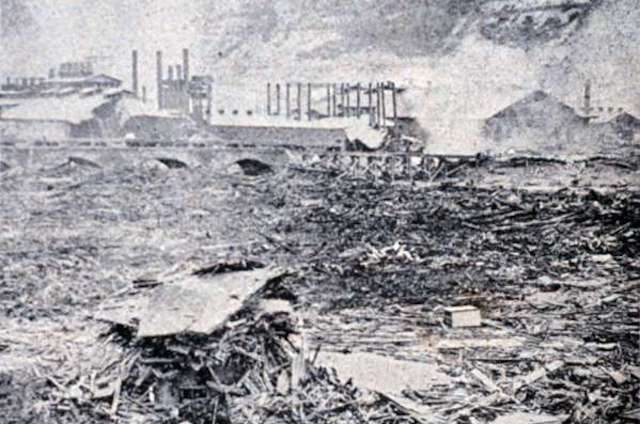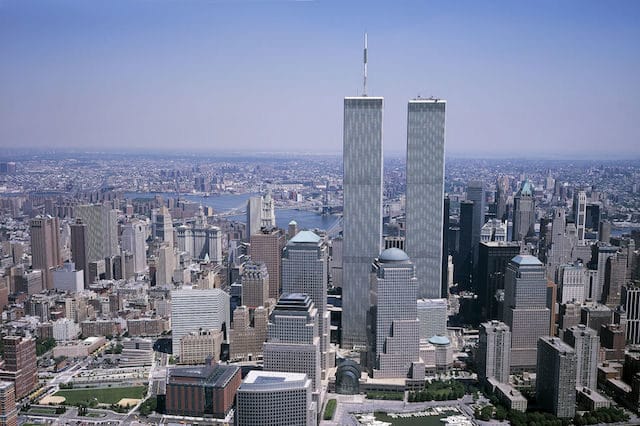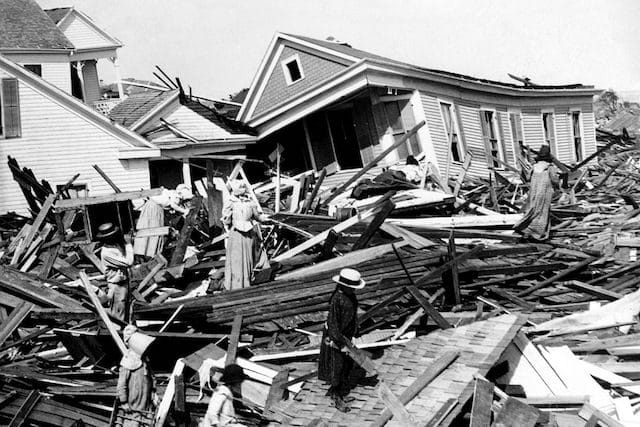Quick: what’s a scary date for you; one that seems filled with foreboding and bad luck? We’re guessing a whole lotta people just plumped for something with a 13 in it, or maybe Halloween. Well, common sense has got news for them. Disasters don’t happen when we expect them to. Instead, they have a habit of flying out of the blue, sowing chaos, and then vanishing, leaving us all standing around wondering what the heck just happened.
And so it is for the deadliest days in American history. We’ve gone digging through the history books, and found what appear to be the 10 days with the highest number of deaths to ever take place on American soil. While some, such as 9/11, won’t surprise you, others you might never have heard of before. And guess what? There’s not a single Friday the 13th among them…
(A quick note before we start: we’re only counting people killed in a single 24-hour period, hence some famous Civil War battles are missing. Got that? Good. Let’s begin!)
10. October 8, 1871: The Peshtigo Fire (Death toll: at least 1,200)
In fall 1871, there was probably nowhere in the United States as flammable as the Wisconsin town of Peshtigo. The summer had been one of the driest in memory, and Peshtigo was right in the epicenter of wildfire territory. Despite this, the buildings were all made of wood, the bridges into the town were made of wood, and the entire town, plus the roads in, were covered in sawdust. If you’re thinking this sounds like a recipe for disaster, congratulations! You’re even more right than you realize.
On October 7, a huge wildfire broke out not far from the town. It spread quickly, swallowing the village of Sugar Bush and killing all its residents. But this turned out to just be the starter before the main course. Winds whipped the fire until it was 200 feet high and burning at 2,000 degrees F. It was so hot, it caused trees it touched to explode like bombs. It was this beast of a fire that blew into Peshtigo shortly after midnight.
The results weren’t pretty. People burned to death in their homes. Those who jumped into the river were boiled alive. All told, over 1,200 Wisconsinites were killed. Yet the nation barely noticed. The Great Chicago Fire had broken out at the same time, and the papers reported that instead.
9. April 9, 1865: Sultana Disaster (Death toll: approx. 1,700)

Don’t be ashamed if you’ve never heard of the Sultana Disaster. Almost no-one has, despite the staggering number of people who were killed. That’s probably due to when it happened. The Sultana sank just after the end of the Civil War, when the press was busy with other, more important stuff. We’re guessing the whole “fourscore and seven years ago” thing was cold comfort to the families of the dead.
The setting was Vicksburg. Newly released Union POWs were being evacuated up the river on steamers, and the government was paying big money for each soldier returned. So steamboat captains were stuffing as many men as possible onto their boats, way beyond the point remotely marked safe. The Sultana’s captain was even worse. When his boiler sprung a leak, he patched it up, desperate not to lose his lucrative commission. He then stuffed 2,300 people onboard a boat built for under 1,000. You can see where this is going.
Shortly after midnight, about five hours after it left Vicksburg, the Sultana exploded. The boilers burst and triggered a massive fire, which killed nearly everyone onboard. The lesson to any steamboat captains reading this? Never cut corners.
8. May 31, 1889: Johnstown Flood (Death toll: 2,209)

Nope, not the far more famous Jonestown Massacre (death toll: 909). The Johnstown Flood was the much deadlier almost-namesake of the 1978 disaster. While it wasn’t malicious, it was powered by a level of stupidity that’s somehow even more maddening. Prior to May 31, 1889, Pennsylvania’s South Fork Fishing and Hunting Club had been asked repeatedly to repair their leaky dam. They didn’t. The night of May 30 was marked by unusually heavy rain. The next morning, the dam finally gave way.
The result was a roaring, roiling wall of water 60 feet high which swept downstream, picking up debris, railcars and barbed wire until it was a gigantic wave of terror and death. It hit the township of Johnstown at 40 miles an hour and proceeded to cause… well. Terror and death.
Most of the town was swept away. When the debris finally crashed to a halt against a railroad bridge they caught fire, meaning survivors of the initial flood were then swept helplessly into a deadly inferno. All told, 2,209 died that day. The Fishing and Hunting Club didn’t pay a dime in compensation.
7. June 27, 1862: Battle of Gaines’ Mill (Death toll: 2,377)

Here’s a little secret about battlefield casualties: most of them aren’t deaths. When you read about “over 50,000 casualties at the Battle of Gettysburg” it’s including those who were captured, wounded, or went missing alongside the dead. Typically, only 20% of the casualties in the Civil War were actually killed, which is why this article ain’t just a list of Civil War battles. The Battle of Gaines’ Mill wasn’t much different in this respect. What changed was the sheer number of total casualties. In less than the time it’d take to rewatch the Lord of the Rings trilogy (extended cuts), 15,000 men were wounded out the war. 2,377 were killed outright.
Part of the Seven Days’ Battles, Gaines’ Mill was a bruising, 9-hour punch up on the fringes of the Confederate capital Richmond. We could go deep into the historical background, but, really, all you need to know is that it was marked by total incompetence on both sides. Confederate generals led their men into battle up a steep hill, allowing Union soldiers to pick them off, while General Cooke on the Union side wasted hundreds of lives in a useless casualty charge. Before the sun had set, over 2,300 were dead.
6. December 7, 1941: The Bombing of Pearl Harbor (Death toll: 2,403)

Of all the sucker punches ever delivered against the USA, perhaps none stung so bad as the attack on Pearl Harbor. At 8 a.m. Sunday morning, hundreds of Japanese bombers appeared out the blue skies over Hawaii and did what bombers do. They destroyed US Navy ships, blew up US planes, crippled the South Pacific fleet, and did so while only sustaining minimal casualties. On the US side, the picture was far less rosy. Over 2,300 servicemen were killed outright, with another hundred or so dying shortly after of their injuries.
You probably don’t need us to tell you what happened next. The “day that shall live in infamy,” as FDR called it, spurred the US into going to war with Japan, which meant also going to war with Italy and Nazi Germany. The result was America entering a little conflict known as World War II, leading to yet more deaths on a colossal scale. Still, it did also lead to no more Hitler, no more Holocaust, and no more militaristic Japan, so that’s a win.
5. September 28, 1928: Okeechobee Hurricane (Death toll: 2,500 minimum)
Back in 1928, hurricane early warning systems weren’t even a pipe dream, which might explain what happened in Palm Beach County, Florida one fateful September day that year. An unnamed storm that had just trashed the Caribbean, killing over 1,500, finally made landfall, at a time when Palm Beach County was utterly unprepared for anything above a minor gale. Those warnings that did arrive just ahead of the storm were mostly ignored. People had seen hurricanes before, and didn’t think they could be that bad.
When the Great Hurricane of ’28 made landfall, it made every previous hurricane look like a mere puff of breeze. Buildings vanished. Trees flew through the air. When it hit Okeechobee Lake, it disintegrated a dike, unleashing a storm surge that flooded the surrounding farming communities. Of the 6,000 people living around the lake, nearly half would be killed, about three quarters of whom were African American laborers. To add insult to injury, the non-white dead didn’t even get markers for their graves.
4. September 11, 2001: 9/11 (Death toll: 2,996)

Of all the other items on this list, maybe only Pearl Harbor lives on so vividly in memory. The only day in the 21st Century to result in anywhere near as many deaths (Hurricane Katrina killed well over a thousand, but over the course of several days), 9/11 was carnage on a scale most of us had never witnessed before. Just after 9am on Tuesday morning, al-Qaeda terrorists slammed planes into the sides of the Twin Towers, before smashing another into the Pentagon and another into a field in Pennsylvania.
Had the day stopped there, it would already have been enough to probably get on this list (many hundreds died on impact in both towers, while another 200 or so died at the Pentagon and in Pennsylvania). As we all already know, sadly it didn’t.
Despite the towers being designed to withstand a hit from a plane, both collapsed, killing hundreds and hundreds more. When the dust finally settled, many days later, and a reckoning could be made, it was discovered more people had died than in the bombing of Pearl Harbor. Somehow, 19 hijackers had managed to cause more carnage than an actual war fleet.
3. April 18, 1906: San Francisco Earthquake (Death toll: 3,000 minimum)
So, here we are. The only three days in which more than 3,000 people were killed on American soil. Appropriately enough, the first one started off with a cataclysmic bang. At 5:13 a.m. on April 18, 1906, San Francisco woke up to the sound of the San Andreas plate shifting, triggering a massive earthquake. The quake itself was bad enough, a violent shaking and tearing that killed an unknown number of people. But it was what came next that really made this day so bloody. The damage triggered a fire which went out of control and tore through the city. People who had just survived a devastating quake found themselves burned alive.
The overall death toll is, incredibly, unknown. We know it was more than 3,000 people, but after that? We’re basically just guessing. Hundreds of deaths in Chinatown are known to have been underreported, and plenty of homeless people likely perished. However, even this disaster did have an upside. The city was reconstructed in a less sprawling, more-logical, and far more earthquake proof way.
2. September 17, 1862: Battle of Antietam (Death toll: 3,650, approx.)

It was the deadliest 24-hour period of the entire Civil War. On September 17, 1862, General Lee’s attempt to invade Maryland was beat back, resulting in death and carnage on a colossal scale. Before the sun went down, some 3,650 Union and Confederate troops would be killed, with another 19,000 wounded or captured. The massacre was so great that we can’t actually say for certain how many people died. Our best guess is that it was something like this number, but possibly many hundreds more.
What’s particularly tragic about Antietam is that it was largely a waste of life. Gettysburg may have killed north of 7,000 (albeit over three days rather than one), but at least that struck a decisive victory for the Union. By contrast, Antietam may have pushed Lee back from Maryland, but it also left him in a strong defensive position, and with fewer of his men killed or wounded than in the Union Army. For all that endless death and awful suffering, effectively nothing had changed.
1. September 8, 1900: the Galveston Hurricane (Death toll: 6,000 minimum)

Remember in the introduction how we said there was no way of telling what day a catastrophe would befall you? Turns out we were wrong. If something terrible happens in the US, it apparently happens in September. After the 1928 hurricane, 9/11, and the deadliest one-day battle of the Civil War, we now have the deadliest natural disaster, and just plain deadliest day in US history. Wow, September, what did we ever do to you?
The Galveston Hurricane was a level of death modern Americans simply have no experience with. Even if you were to combine the deaths of 9/11 and Hurricane Katrina and every terror attack from September 12, 2001 onwards, you still wouldn’t touch the Galveston disaster. A small island off the coast of Texas, it was once a massive vacation spot. On September 8, authorities issued last minute warnings of an incoming hurricane, urging people to get to high ground. Most of those on vacation didn’t listen. Whoops.
Galveston is only 9ft above sea level. As the hurricane hit, a storm surge 15 feet high overwhelmed the island, washing thousands of people away. Somewhere between 6,000 and 8,000 drowned, a stupefying death toll. Hopefully, it will never be exceeded.
Other Articles you Might Like
2 Comments
Pingback: Facts of Life from the 28th Century (From Someone Who's Supposedly Been There) - Toptenz.net
“When it hit Okeechobee Lake, it disintegrated a dyke”…say what?